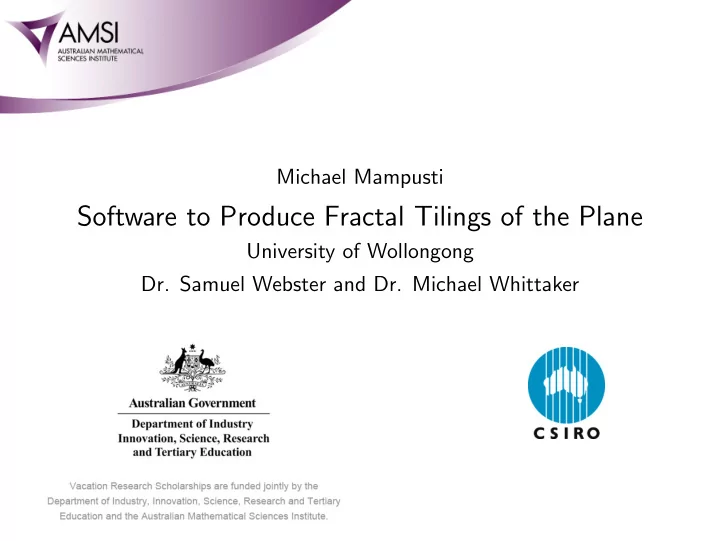

Michael Mampusti Software to Produce Fractal Tilings of the Plane University of Wollongong Dr. Samuel Webster and Dr. Michael Whittaker
Why make Fractal Tilings? ◮ they look so awesome! ◮ aperiodic tilings are hard to construct. We can build an infinity of substitution tilings from aperiodic tilings.
Why make Fractal Tilings? ◮ they look so awesome! ◮ aperiodic tilings are hard to construct. We can build an infinity of substitution tilings from aperiodic tilings. ◮ ...
Why make Fractal Tilings? ◮ they look so awesome! ◮ aperiodic tilings are hard to construct. We can build an infinity of substitution tilings from aperiodic tilings. ◮ ... ◮ FRACTALZ!!!
Tilings of the Plane ◮ a cover of R 2 with shapes, called tiles . Example (Tiled bathroom floor)
More formally, a tiling of the plane is a set of compact subsets of R 2 , T := { t i : i ∈ N } such that � t i = R 2 , i ∈ N and int( t i ) ∩ int( t j ) = ∅ for all i � = j . Each t i is called a tile .
We only care about tilings which: ◮ are made up of finitely many tile types (up to rigid motions), called prototiles ; and ◮ are aperiodic (there exists no translation of the tiling which matches up with the original tiling). Example (Tiled bathroom floor) This is not an aperiodic tiling since translation by length of the tile gives you back the same tiling.
Substitution Tilings ◮ Defined using substitution rules on the set of prototiles: ◮ expand, tile and contract. Example (Tiled bathroom floor) �
A nice example of a substitution tiling is the Penrose tiling . It consists of 4 prototiles. The substitution rules are as follows:
This is an aperiodic tiling of the plane.
Programming in Mathematica ◮ write prototiles ( p 1 , . . . , p n ) as a vector. ◮ developed a special matrix which we applied to the vector. Special Matrix (The Tile Breaker) ◮ ij th entry contains all the rotations and translations of p j in substitution of p i . ◮ application of The Tile Breaker breaks up the prototiles into parts according to the substitution rules. ◮ discovering The Tile Breaker and implementing it in Mathematica was non-trivial.
Fractals Contraction Mappings ◮ a map f : R 2 → R 2 which brings points closer together Iterated Function Systems (IFSs) ◮ let f 1 , . . . , f n be contractions on R 2 . ◮ R 2 with these contractions is an iterated function system.
Consider H ( R 2 ), the space of compact subsets of R 2 . Theorem ([1], Theorem 7.1) Given an IFS ( R 2 with f 1 , . . . , f n contractions ) , the function f : H ( R 2 ) → H ( R 2 ) defined by n � f ( B ) = f i ( B ) , i =1 is a contraction on H ( R 2 ) . There exists a unique fixed point A ∈ H ( R 2 ) of f called the attractor. It satisfies n →∞ f n ( B ) , for any B ∈ H ( R 2 ) . A = lim
Examples (Koch Curve and Sierpinski Gasket)
Fractal Tilings ◮ tilings of the plane. ◮ tiles have fractal edges; fractiles . ◮ we build them from existing substitution tilings. Example (Half-Hex Tiling) �
◮ inscribe dual graph in each prototile.
◮ take a few substitutions of original tiling with graphs inscribed
◮ choose edges in substitution which resembles original graph
◮ iterate edges infinitely. →
◮ inscribe final fractal edges into original prototiles.
◮ tile plane with fractal edges inscribed.
Programming in Mathematica ◮ take The Tile Breaker from substitution tiling and build a special edge matrix, called The Fractalix . ◮ apply it to the vector of edges similar to the prototiles. ◮ choosing edges deletes entries in this special edge matrix. ◮ each entry in the matrix is not only a rotation and translation, it is also a contraction. In this way, we have an (generalized) IFS with the fractal edges as the attractors!
1.5 10 3 2 1.0 5 1 0.5 � , , , � 2 � 1 1 2 3 � 5 5 10 � 1 � 0.5 0.5 1.0 1.5 � 5 � 2 � 0.5 � 3 1.2 1.0 1.0 1.0 1.0 0.8 0.8 0.8 0.8 0.6 0.6 0.6 0.6 , , , � 0.4 0.4 0.4 0.4 0.2 0.2 0.2 0.2 0.2 0.4 0.6 0.8 1.0 1.2 0.2 0.4 0.6 0.8 1.0 0.2 0.4 0.6 0.8 1.0 0.2 0.4 0.6 0.8 1.0 � 0.2
Here is a fractal tiling built from the Penrose substitution.
Octagonal Tiling
Here is a fractal tiling built from the Octagonal substitution.
Equithirds Tiling
Here is a fractal tiling built from the Equithirds substitution.
Further directions I plan to explore: 1. use Mathematica to extract the fractiles and substitution; 2. put code on the Wolfram website for public use; 3. update the Tiling Encylopedia to include some of the fractal tilings we made; 4. look at other types of tilings; and 5. most importantly, write up work for publication.
M. F. Barnsley, Fractals Everywhere , Second edition, Academic Press Professional, Boston, 1993. N. P. Frank and M. F. Whittaker, A Fractal Version of the Pinwheel Tiling , Math. Intellig. 33:2 (2011), 7-17. L. Sadun, Topology of tiling spaces , AMS University Lecture Series, 46, Providence RI, 2008. The Tiling Encyclopedia, Web address: http://tilings.math.uni-bielefeld.de/
Recommend
More recommend